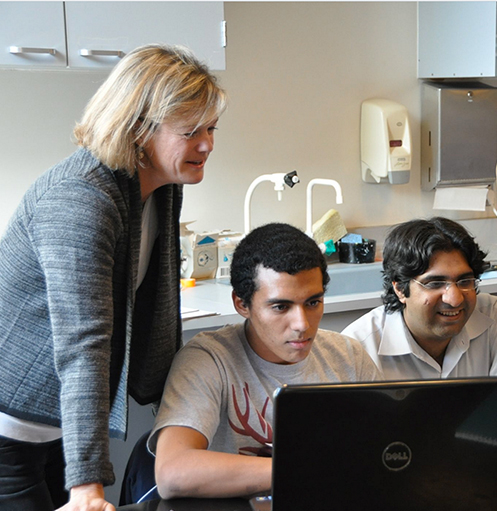Recall the first time you realized the sun was a star, or viewed through a microscope the abundance of life contained in a drop of pond water, and you’ll catch a glimpse of the wonder Emily Wiley hopes to instill in her students.
 An avid puzzle-solver and self-proclaimed fan of the “why” questions, her approach to education involves aiding and celebrating the “aha” moments of scientific discovery. In the Wiley Lab, a place of serious genomics research, you may even witness the sudden activation of a disco ball and accompanying retro music.
An avid puzzle-solver and self-proclaimed fan of the “why” questions, her approach to education involves aiding and celebrating the “aha” moments of scientific discovery. In the Wiley Lab, a place of serious genomics research, you may even witness the sudden activation of a disco ball and accompanying retro music.
“In any study there’s a point where the outcome makes or breaks your hypothesis. So when students rush in excitedly with their results, we grab each other, jump up and down, and fire up the disco ball,” says Wiley, who teaches biology at the W.M. Keck Science Department. “We’re set up for discovery moments like that, and I try to make it fun.”
Wiley’s own moments include an undergrad research experience where she determined that certain marine bacteria relied on oxygen, not nitrogen to glow. “At the time, I thought I was the only person in the world who knew this information, so it was thrilling,” she says.
More recently, she detected a way for undergraduate students to practice budding science skills while contributing to the wider scientific community.
The idea emerged when Wiley considered the lack of genomic data for the model organism Tetrahymena thermophila—a protozoan found in streams, lakes and ponds—that’s used in college research labs nationwide. Although its genome has been completely sequenced, only about 200 of Tetrahymena’s known 28,000 genes have been functionally characterized.
So in 2006, with the help of a National Science Foundation CAREER award, Wiley founded the Ciliate Genomics Consortium (CGC), a national collaborative that involves students in research to identify gene functions in the Tetrahymena genome. The experiments are built into educational modules that integrate with molecular and cell biology courses.
Students “adopt” a gene and then perform the tasks outlined in the modules. They may look at when in the cell cycle a particular gene turns on or off, for example, or see what happens when they remove, or “knock out,” the gene. Such information can reveal clues about the gene’s function. Student findings are logged online and linked electronically with the official Tetrahymena genome database used by the global scientific community. When a researcher views a page about a gene a student has studied, the page will include a hyperlink to the student’s report.
“Students become generators of new scientific knowledge, and that’s when the real connections between content and science process are made,” Wiley says. “I’ve seen students become more invested in the work, because they’re doing it for the good of the larger scientific community and not just for a grade in my class.”
More than 800 students have participated in the research since the program’s start, and 20 colleges and universities nationwide now use the modules as part of their curricula. Thanks to a recently awarded $506,131 NSF grant, Wiley hopes to expand the CGC’s reach to include more modules and institutional participants.
Her own interest in molecular biology emerged while pursuing a bachelor’s degree at Western Washington University. She recalls a particular “aha” moment that occurred while listening to an instructor explain all the molecular events that must happen for someone to be able to move a body part. “I shifted my finger up and down and went, ‘Whoa.’ The fact that you could understand things like that at a molecular level really captivated me.”
Wiley went on to earn her doctorate in molecular genetics and has been sharing the discovery and joy of scientific research with her students ever since.
Through her work with the CGC, she hopes to inspire colleagues nationwide to “think big” and embrace their limitless possibilities as scientists and educators.
“With the highly collaborative way science is done these days, if you think creatively, you’ll see it doesn’t have to be just within a well-established research group. I discovered a goldmine in undergraduates’ brains and hands,” she says. “And we’re giving these students a chance to see what they’re capable of, to see themselves as real scientists. And that hooks them forever.”
Wetmore is a freelance writer who specializes in science.